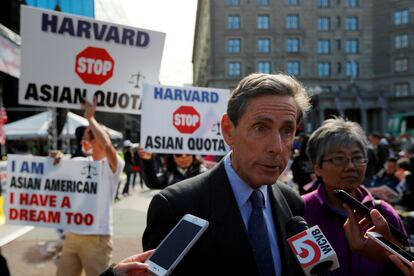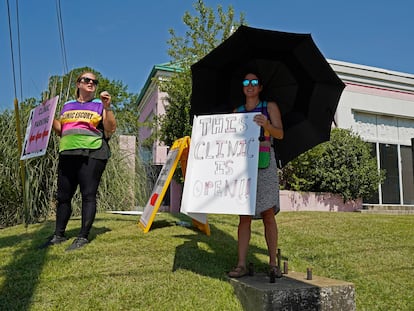US Supreme Court considers ending affirmative action in universities
The conservative-majority court is studying lawsuits filed against Harvard and the University of North Carolina that want to stop race from being considered by admissions committees


When the Supreme Court of the United States struck down Roe v. Wade in June 2022, ending the constitutional right to abortion, it appeared that the conservative-majority bench was readying itself to engage in a level of right-wing judicial activism unseen in decades. Now, with the issue of affirmative action in higher education, the stage is set for another battle.
The Supreme Court – made up of six conservative justices (three of them appointed by former US president Donald Trump) and three liberals – is considering limiting or abolishing affirmative action in higher education, which is the policy of favoring the admission of high-performing students from racial groups that have historically been discriminated against. Since the late-1960s, several American universities have put racial quotas in place to help Black and Latino students access an educational system that was long closed to them.
Edward Blum – the founder of Students for Fair Admissions (SFFA) – is an activist against affirmative action policies. He believes that these practices harm white and Asian-American students.
Blum – a right-wing legal strategist who is not an attorney – is the organizer of the lawsuits filed against Harvard University and the University of North Carolina (UNC) by SFFA. Both universities presented their defense to the Supreme Court on Monday, October 31, 2022.
The arguments have made frequent reference to Brown v. Board of Education – a landmark decision by the Supreme Court in 1954, which ruled that racial segregation in public schools was unconstitutional. This ruling offered legal precedent that paved the way for integration at all educational levels. It was a starting point to justify affirmative action policies in prestigious colleges and universities that, historically, were restricted to non-whites.
The two universities being sued maintain that Brown v. Board of Education promoted equal opportunities in a broad sense. Therefore, it allows institutions – such as Havard and UNC – to help minorities overcome difficulties caused by structural racism, which have placed them at a disadvantage in American society.
SFFA, meanwhile, argues that admission processes should be blind to racial considerations and that taking race into account to positively discriminate against some groups results in negatively discriminating against others, thus violating the right to equality enshrined in the Constitution of the United States.
“The Brown case definitively and firmly rejected the view that racial classifications have any role to play in the provision of educational opportunity,” claimed Patrick Strawbridge, an attorney for SFFA. He argued that affirmative action in admission to universities “is a flagrant exception to that rule.”
Justice Elena Kagan – one of the three Democratic appointees on the court – questioned SFFA’s arguments. She pointed out that racial diversity in the university system is necessary to facilitate diversity in leadership positions in the economy, in politics and in society as a whole.
While Stawbridge admitted that positive discrimination was acceptable when it came to socioeconomic, religious or gender factors, he insisted that positive discrimination based on racial considerations is unconstitutional.
Kagan also questioned Strawbridge – a member of the conservative Federalist Society and a former Trump attorney – about how a race-insensitive policy would assess applicants whose race is linked to their personal history. The example she gave was that of a first-generation college student descended from slaves. Strawbridge responded that personal history and cultural factors should be taken into account, but not race. Kagan considered this to be a weak answer.
Justice Ketanji Brown Jackson – the first Black woman on the Supreme Court, appointed by President Biden – can only rule on the case concerning North Carolina, as she was once part of the Harvard admissions committee. She expressed skepticism at the notion – presented by SFFA’s lawyers – that admissions committees only consider race in isolation. “They’re looking at the full person, with all their characteristics.”

“Diversity is our nation’s greatest source of strength,” said Ryan Park, a lawyer defending the University of North Carolina. “And for that democracy to flourish, people of all different backgrounds and perspectives have to learn to live together and come together in common purpose. [Brown v. Board of Education] intended that education be the engine of our democracy,” he added.
“I have heard the word ‘diversity’ many times and I have no idea what it means,” replied Justice Clarence Thomas, a conservative of African-American descent. Thomas was appointed to the court in 1991 by President George H. W. Bush, despite being accused of sexually harassing multiple women. He has long been an opponent of gender or racial quotas.
There are indications that the conservative majority on the court is preparing to use this lawsuit to end race-conscious university admissions, which could possibly lead to them striking down all forms of affirmative action across all sectors of American society.
In a 2007 ruling, Chief Justice John Roberts expressed his opposition to a Seattle-based program aimed at desegregating schools: “The best way to stop discrimination on the basis of race… is to stop discriminating on the basis of race.”
Now, with the most conservative Supreme Court in half-a-century behind him, it appears as if his view can finally be applied.
Tu suscripción se está usando en otro dispositivo
¿Quieres añadir otro usuario a tu suscripción?
Si continúas leyendo en este dispositivo, no se podrá leer en el otro.
FlechaTu suscripción se está usando en otro dispositivo y solo puedes acceder a EL PAÍS desde un dispositivo a la vez.
Si quieres compartir tu cuenta, cambia tu suscripción a la modalidad Premium, así podrás añadir otro usuario. Cada uno accederá con su propia cuenta de email, lo que os permitirá personalizar vuestra experiencia en EL PAÍS.
¿Tienes una suscripción de empresa? Accede aquí para contratar más cuentas.
En el caso de no saber quién está usando tu cuenta, te recomendamos cambiar tu contraseña aquí.
Si decides continuar compartiendo tu cuenta, este mensaje se mostrará en tu dispositivo y en el de la otra persona que está usando tu cuenta de forma indefinida, afectando a tu experiencia de lectura. Puedes consultar aquí los términos y condiciones de la suscripción digital.
More information
Archived In
Últimas noticias
Raúl Rocha, from jet-setting with Miss Universe to arms trafficking and fuel theft
80,000 barrels of Mexican oil sent to Cuba: Havana drawn into the US–Mexico clash
Human rights activists, opposition members, and a minor: Maduro’s other political prisoners
Israel sparks a civil war within the MAGA movement
Most viewed
- Reinhard Genzel, Nobel laureate in physics: ‘One-minute videos will never give you the truth’
- Pablo Escobar’s hippos: A serious environmental problem, 40 years on
- Charles Dubouloz, mountaineering star, retires at 36 with a farewell tour inspired by Walter Bonatti
- Why we lost the habit of sleeping in two segments and how that changed our sense of time
- The fall of a prolific science journal exposes the billion-dollar profits of scientific publishing










































